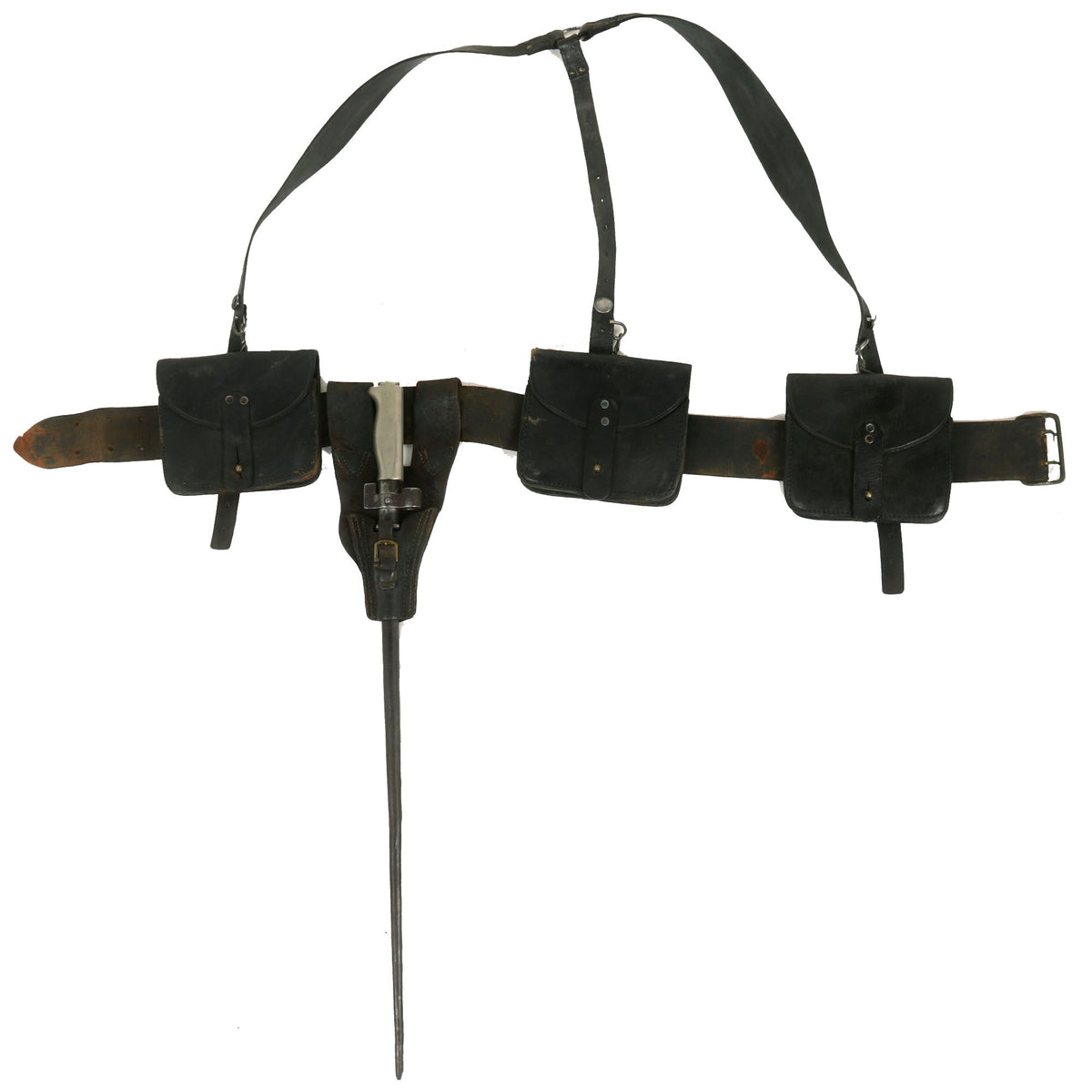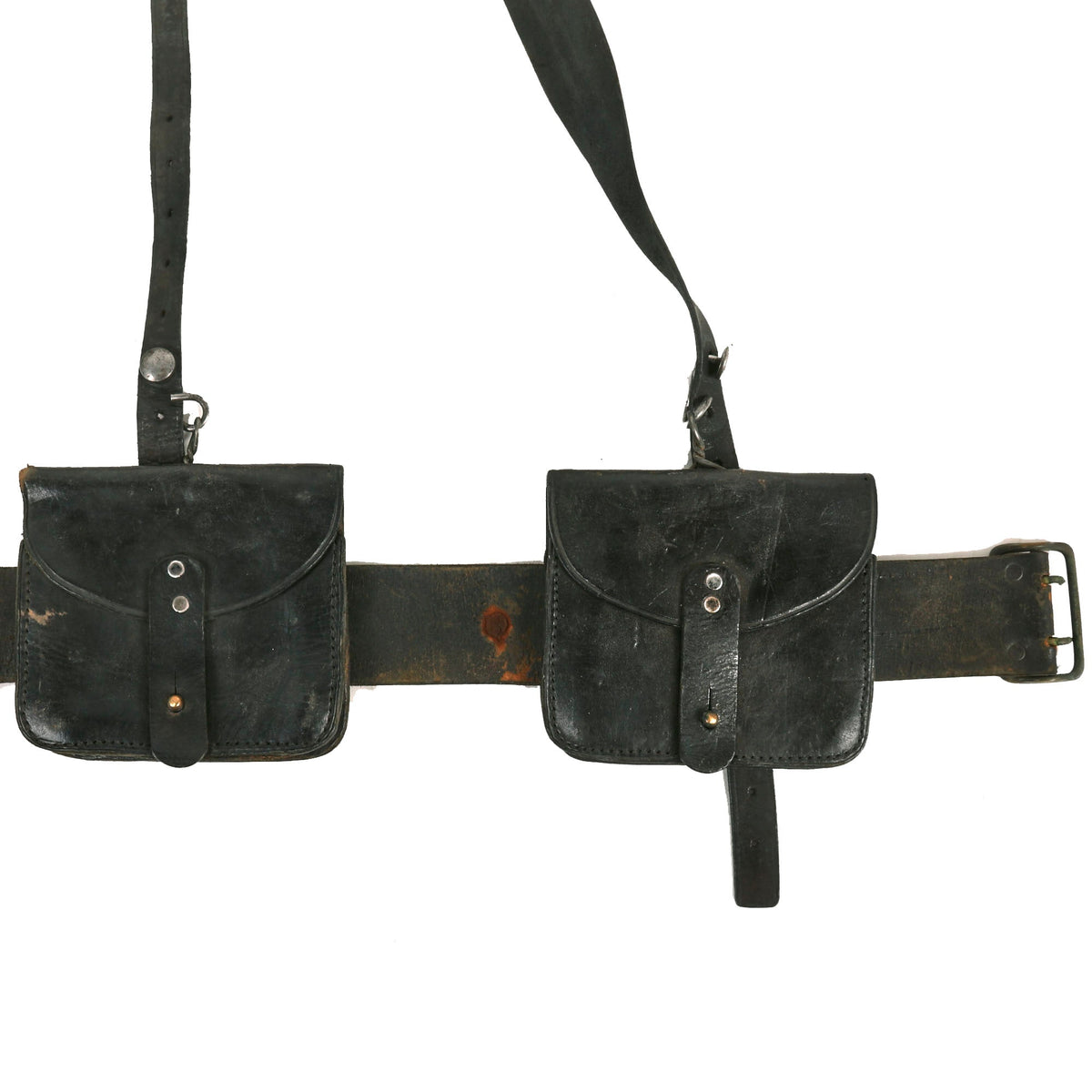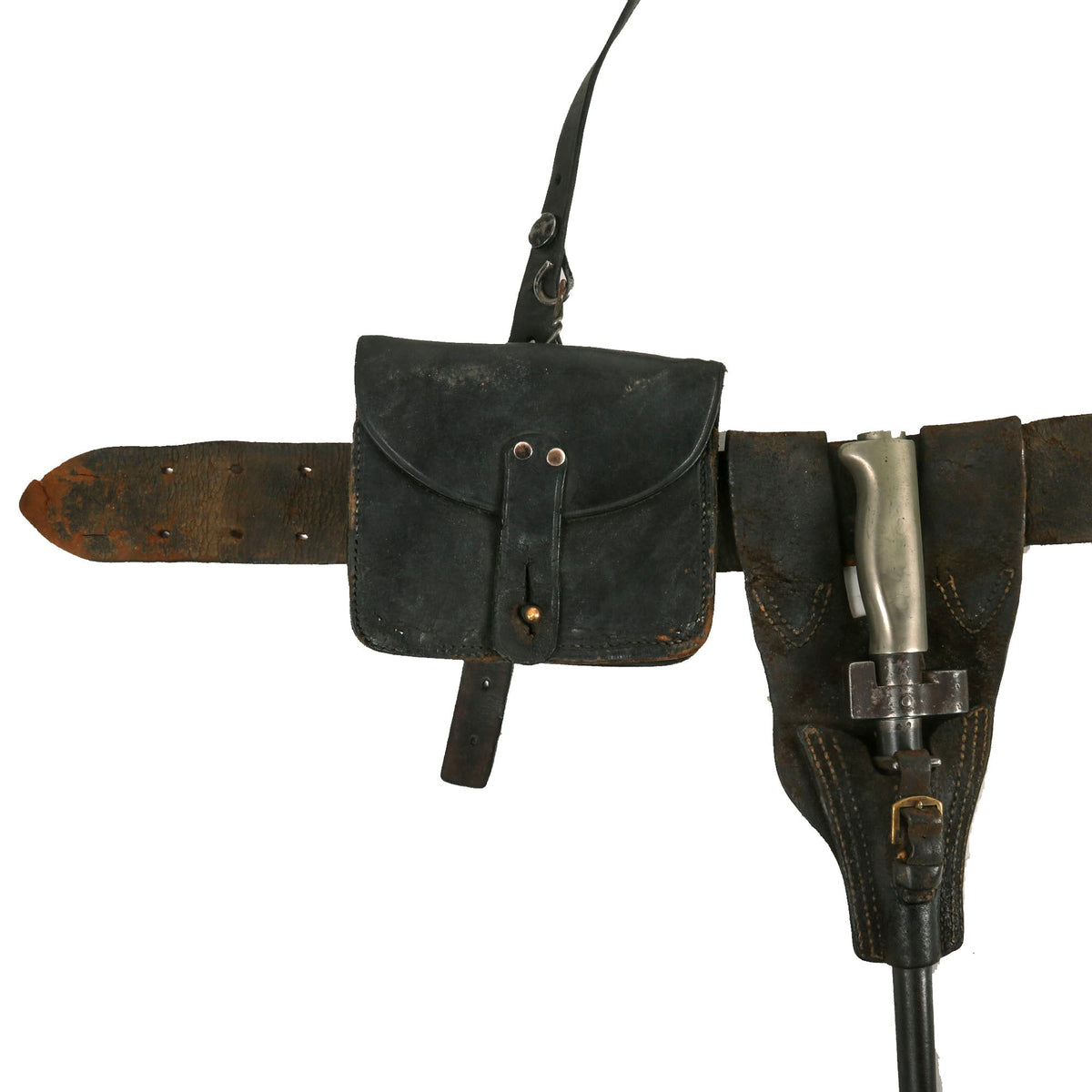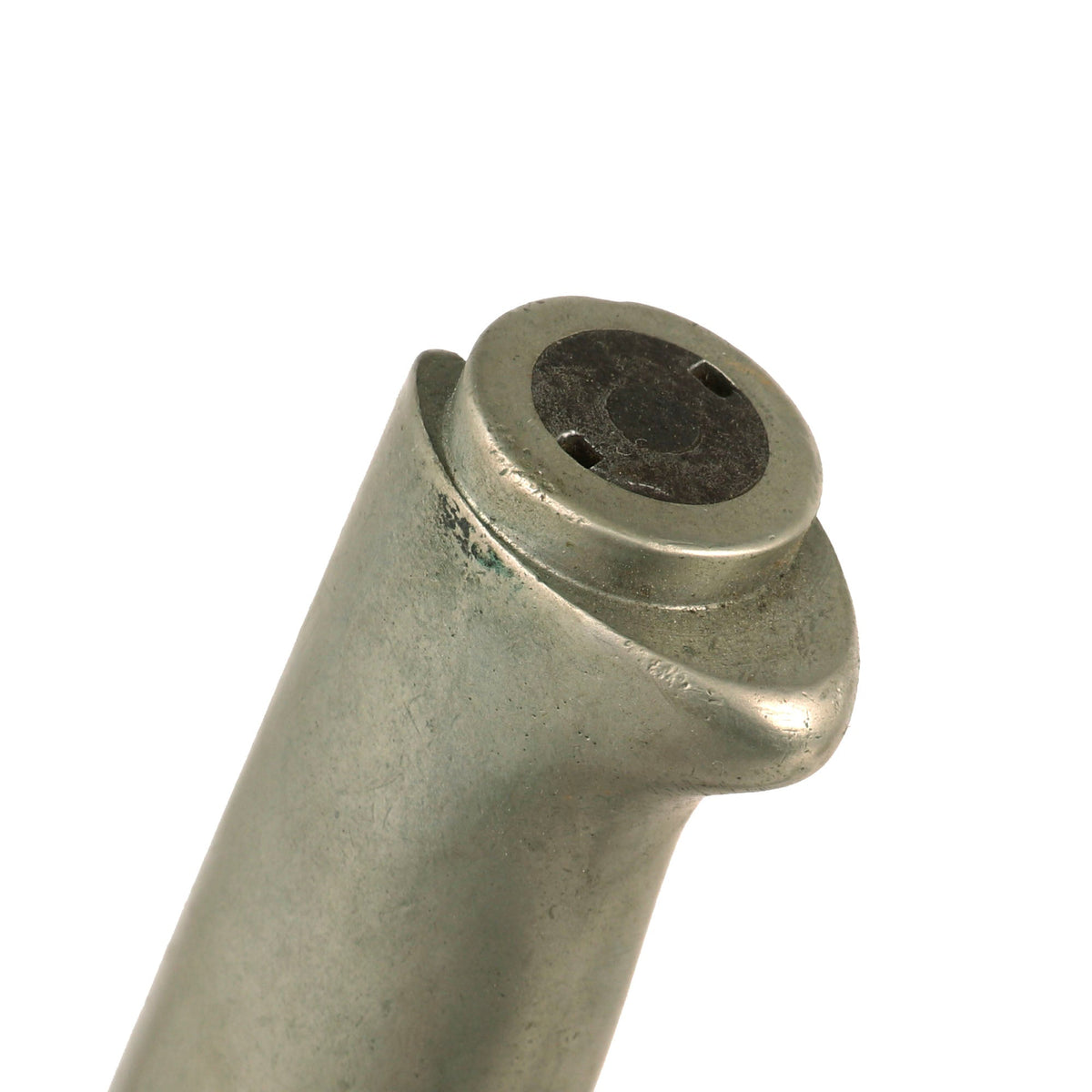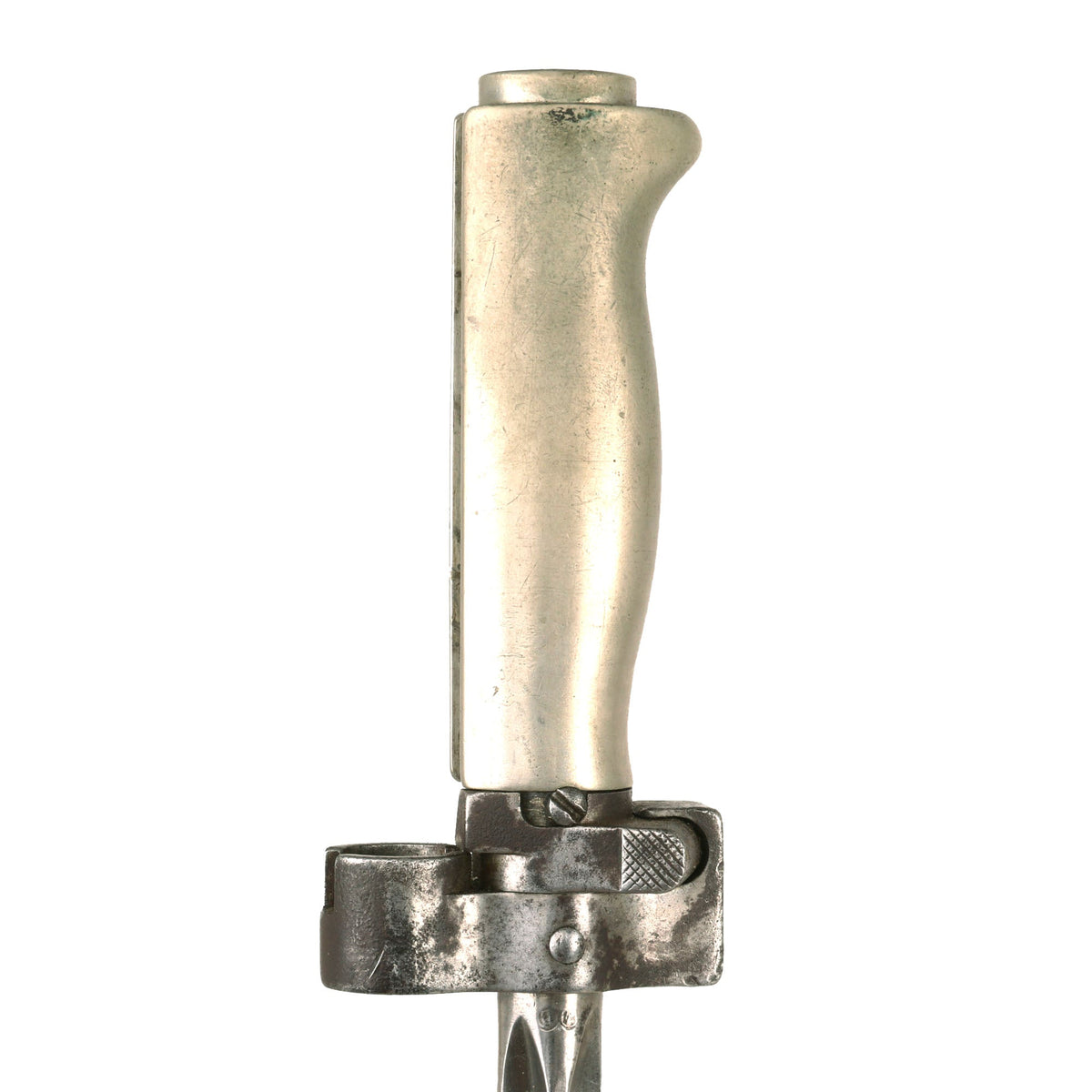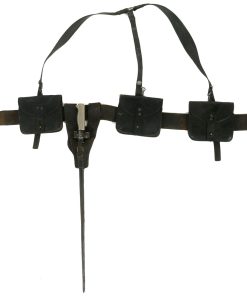Original French WWI Infantry Model 1903 Leather Belt With 1892/14 Suspenders, M1905/14 Cartridge Pouches and Lebel Cruciform Épée Bayonet With M1888/14 Leather Frog Original Items
$ 795,00 $ 238,50
Original Items: Only One Set Available. This is an excellent opportunity to add a basic rifleman’s belt rig to your collections, and a rather rare one at that. The rig itself is in wonderful condition and all date to the early war period of 1914/15 given the construction of each item. During World War I, France was one of the Triple Entente powers allied against the Central Powers. Although fighting occurred worldwide, the bulk of the French Army’s operations occurred in Belgium, Luxembourg, France and Alsace-Lorraine along what came to be known as the Western Front, which consisted mainly of trench warfare. Specific operational, tactical, and strategic decisions by the high command on both sides of the conflict led to shifts in organizational capacity, as the French Army tried to respond to day-to-day fighting and long-term strategic and operational agendas. In particular, many problems caused the French high command to re-evaluate standard procedures, revise its command structures, re-equip the army, and to develop different tactical approaches.
The Items In This Group:
– Model 1903/14 le Ceinturon (“Belt”): Adopted almost 75 years before the start of the Great War, the M1845 had been the regulation belt of the French army fighting in the Franco-Prussian War. With its large rectangular brass plate-buckle and antiquated design, it would be relied on again in 1914, with the vast majority of infantry troops issued it despite the presence of the M1903 belt.
The regulation of 9 December 1914, which redefined the uniforms of the French army on a whole, adopted that from then on, all French leather gear would no longer be blackened but would be left in its natural tan color called ‘fauve’. Additionally, all leather items were now made with the smooth grain side facing out. The first M1903/14s were distributed to new recruits and returning wounded before joining their front-line units beginning in the spring of 1915. Gradually the new belts were distributed to all front-line troops, replacing the black leather items. The width of the M1903/14 belt remained unchanged from its predecessor at 55 mm, and likewise came in three lengths: 110, 115 and 125 cm. Per regulations, the number of holes remained the same: 11 pairs of holes (22 in total) though this one has 7 pairs of holes. The buckle assembly also remained the same as the 1903, a brass two-pronged buckle, with the exception that the buckle frame now had rounded corners. As a matter of economy, later versions of the M1903/14 were made with japanned (black lacquered) buckle assemblies as well, though it is believed this version was widely distributed.
The overall condition of the belt itself is lovely but is heavily worn with tearing present.
– Model 1892/14 le Bretelles de Suspension (“Suspenders”): As noted above with the belt, the regulation of 9 December 1914 stipulated that from then on all French leather gear would no longer be blackened, instead being left in its natural tan color called ‘fauve’ and with the grain side facing out. Aside from this change, the regulation suspenders remained unchanged in form for the rest of the war, including leaving the number of punched holes at 9 like on this one. Like the new belts, the first M1892/14s were distributed to new recruits and returning wounded before joining their front-line units beginning in the spring of 1915.
One minor modification to the suspenders came with the introduction of hooks that resembled a lower case “d” (the shape was intended to counteract the habit of the hooks becoming undone from the cartridge pouches) made in either brass or japanned iron. Due to the weakness of the seams where the straps joined the dorsal ring, rivets would begin to be added to the Model 1892/14 suspenders at production, though entirely sewn versions continued to be made until the end of the war.
The suspenders themselves are in solid condition with all components appearing to be present and in working order.
– (3) 1905/14 les Cartouchières (“Cartridge Pouches”): As with other leather gear, economized cartridge pouches were made in the first urgent months of the war which utilized either a combination of sewn seams and rivets (brass or iron) or all rivets. M1905 and M1905/14s alike were produced using a variety of rivet sizes and layouts. Both flat and round-headed finials were used in these economized versions.
All three are in wonderful condition and are the wartime construction with a combination of stitches and rivets. They are still solid but do have areas of material loss, tearing and popped stitching.
– Model 1888/14 la Porte-Baïonette (“Bayonet Carrier”): Like other leather accouterments of the French army, the bayonet carrier (or frog, as it is often known) had changed very little in design in the decades before the Great War. The frog for the M1886 épée-bayonet was similar to that made for the Gras saber-bayonet and was exceedingly simple in design. Like its predecessor the M1888 frog featured a small strap that fed through the corresponding strap loop on the scabbard which secured it to the frog, as well as the two parallel belt loops that allowed for the cloth belt loop on the greatcoat to fit between them. The M1888 was blackened on the flesh side only, with the flesh side of the leather facing out. The small buckle that adorned the frog was made of brass. The frog was entirely sewn, with no reinforcement rivets.
As with the other leather accouterments, in December 1914 the M1888 frog began to be produced in its natural tan and with the grain side facing out. Otherwise, no other modifications were made. Like it’s predecessor, the regulation M1888/14 was also entirely sewn with no incorporation of rivets. The buckle was made both in brass and blackened metal.
This example is entirely sewn and in fantastic condition given the age.
– Lebel M.1886/93/07/16 Cruciform Épée Bayonet with Scabbard: Known affectionately as “Rosalie” to French troops, the M1886 was the French mainstay during WWI and many were still in service at the Fall of France in 1940. The Lebel also saw extensive use worldwide by native troops in the French colonies. The M1886 introduced the distinctive cruciform “Épée” blade, which remained a feature of most French bayonets until 1956. This was intended to create such a terrible would that because of it’s shape torn open very easily condemning the poor recipient to a very painful and long recovery.
The bayonet design underwent many revisions during service history. The very first model is identified by a brass grip with a very small steel tang rod shown on the pommel of the bayonet. This was swiftly replaced with Nickel gripped version like this one,and several other versions followed in 1893 and 1907, removing the “hook quillon”.
The bayonet and scabbard are both marked with various proofs and maker marks, which we are unfortunately unable to identify. The serial numbers do not appear to be matched. Condition is very good, and both the scabbard and bayonet are partly covered in dried arsenal preservative, which has a brownish color. We do not see any major wear or damage to the bayonet or scabbard.
This is a lovely set of French WWI leather accouterments. Though the leather is worn and torn in spots, this is still a very nice set up, one that is rarely encountered. Comes more than ready for further research and display.
Fast Shipping with Professional Packaging
Thanks to our longstanding association with UPS FedEx DHL, and other major international carriers, we are able to provide a range of shipping options. Our warehouse staff is expertly trained and will wrap your products according to our exact and precise specifications. Prior to shipping, your goods will be thoroughly examined and securely secured. We ship to thousands clients each day across multiple countries. This shows how we're dedicated to be the largest retailer on the internet. Warehouses and distribution centres can be located throughout Europe as well as the USA.
Note: Orders with more than one item will be assigned a processing date depending on the item.
Before shipping before shipping, we'll conduct a thorough inspection of the items you have ordered. Today, the majority of orders will be delivered within 48 hours. The delivery time will be between 3-7 days.
Returns
The stock is dynamic and we cannot completely manage it because multiple stakeholders are involved, including our factory and warehouse. So the actual stock may alter at any time. It's possible that you may not receive your order once the order has been made.
Our policy is valid for a period of 30 days. If you don't receive the product within 30 days, we are not able to issue a refund or an exchange.
You can only return an item if it is unused and in the same state as the day you received it. You must have the item in its original packaging.
Related products
Uncategorized
Uncategorized
Uncategorized
Uncategorized
Australian WWII Owen MK1 Machine Carbine SMG Custom Fabricated Replica with Sling Original Items
Uncategorized
Uncategorized
Uncategorized
Uncategorized
Uncategorized
Uncategorized
Armoured Fighting Vehicles of the World: AFVs of World War One (Hardcover Book) New Made Items
Uncategorized
Uncategorized
Uncategorized
Uncategorized
Armored Burgonet Helmet & Polearm from Scottish Castle Leith Hall Circa 1700 Original Items
Uncategorized
Uncategorized
Uncategorized
Uncategorized
